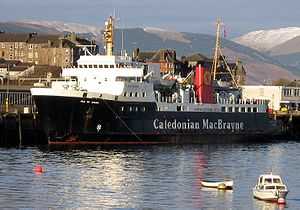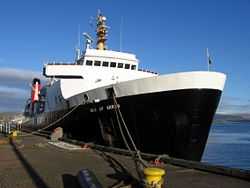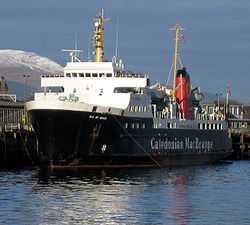MV Isle of Arran
 MV Isle of Arran at Gourock pier | |
| Career (UK) | |
|---|---|
| Name: | MV Isle of Arran |
| Owner: | Caledonian Maritime Assets Limited |
| Operator: | Caledonian MacBrayne |
| Route: |
Ardrossan - Brodick/Campbeltown (summer) Spare vessel (winter) |
| Builder: | Ferguson Ailsa Ltd, Port Glasgow |
| Yard number: | 491[1] |
| Launched: |
2 December 1983 by Miss Joanna Younger, daughter of the then Secretary of State |
| Maiden voyage: | 13 April 1984 |
| Homeport: | Glasgow |
| Identification: |
IMO number: 8219554 Callsign: GDMJ |
| Status: | in service |
| General characteristics | |
| Class and type: | vehicle and passenger ferry |
| Tonnage: | 3,269 |
| Length: | 84.92 m (278.6 ft) |
| Beam: | 16.24 m (53.3 ft) |
| Draft: | 3 m (9.8 ft) |
| Propulsion: | 2 x 8MB275 diesel engines, each developing 2310bhp |
| Speed: | 15 knots (28 km/h; 17 mph) (service) |
| Capacity: | 448 passengers 76 cars |
| Crew: | 20 |
| Notes: | [2] |
MV Isle of Arran is a drive-through ferry owned by Caledonian Maritime Assets Limited and operated on the west coast of Scotland by Caledonian MacBrayne. Built in 1983, she served on the Arran service for ten years before being moved to Kennacraig. With increasing age, she has been the winter relief vessel. In 2013, she started a new pilot route from Ardrossan to Campbeltown.
History
Over the years, MV Isle of Arran has seen complete contrasts in her regular employment - a ship which started out as the main ferry on a busy route, where she was overwhelmed by her own success - redeployed to another route, where she brought ro-ro capabilities and latterly transferred to a role in which she was one of the most well-traveled members of the fleet. She has been a real workhorse, providing an essential service for over 30 years.[3]
Isle of Arran was launched on the Clyde at the end of 1983. After fitting out, she made her way down to Gourock, where she showed the flag and tested her bow ramp on the linkspan. After further berthing trials at Ardrossan and Brodick, she eventually took over the route on 13 April 1984 from MV Glen Sannox, which itself had recently replaced the failed MV Clansman. She became a great asset to the Clyde-based fleet, with a crossing time to Arran of 55 minutes. Her winter relieving vessels included the MV Iona of 1970 and even the elderly Glen Sannox.[3]
However, by the turn of the decade, it was clear that Isle of Arran was becoming inadequate for the role for which she was built. In 1993, less than ten years after her launch, she made way for the mighty MV Caledonian Isles and left for the Kennacraig to Islay crossings. Replacing MV Claymore, she brought drive-through capabilities to that route. Despite a much larger vehicle capacity, she could discharge a full load and take on another in the same, if not less, time than the Claymore. Throughout the summer she made two or three return trips each day to Islay. On Wednesdays during high summer, her roster took her on past Port Askaig to Colonsay and Oban, returning to Kennacraig after dark. The winter months saw Claymore or Iona on the Islay sailings and Isle of Arran took on a general relief role for the other large vessels at Oban, Ardrossan, Ullapool and Uig. She saw service on the majority of the drive-through routes on the west coast, while continuing to have her own commitment to Islay during the summer. From the end of 1998, Clansman took the Arran and Lewis relief sailings and Isle of Arran relieved where needed.[3]
With the introduction of MV Hebrides on the "Uig triangle" in March 2001, MV Hebridean Isles moved south to become the regular Islay ship, and Isle of Arran became the spare vessel. An army charter took her from Ardrossan to Campbeltown in the autumn of 2001.[3]

In 2002, she took up an experimental summer arrangement as a third large ship based in Oban, along with MV Isle of Mull and MV Clansman. Isle of Arran was able to improve several routes, carrying out additional sailings on a new roster incorporating runs to Colonsay, Coll, Tiree, Barra, South Uist and Mull. A new weekly sailing on a Thursday took her to Scarinish on Tiree, through the Gunna Sound and across the Minch to Castlebay for mid-afternoon before retracing her steps to arrive back in Oban late in the evening. This new duty was a big success with islanders and tourists alike. Isle of Arran pioneered this new duty roster but MV Lord of the Isles was to continue it in 2003, once the new MV Coruisk arrived at Mallaig. The duty allocations were redefined with Clansman taking the majority of the Coll and Tiree sailings, and LOTI concentrating mainly on the Outer Isles and Colonsay.[3]
2003 and 2004 saw Isle of Arran back at Islay for the high summer, partnering her replacement, MV Hebridean Isles, on a two-ship roster. There was essentially double capacity on this route, and Islay could still be served on a Wednesday whilst Hebridean Isles was off to Colonsay and Oban. These additional sailings to Islay were marked as such in the timetable, and could be cancelled at short notice if the vessel was required elsewhere; Isle of Arran was still the relief vessel. Prior to the start of the 2004 season she spent a good deal of time in the James Watt Dock undergoing fairly major work to completely replace her car deck. At the end of that season she ventured north to Stornoway, where she had previously begun a new duty – relief for the freight vessel MV Muirneag. During this spell, idle on Lewis she was joined by the Clansman – herself relieving MV Isle of Lewis on the main ferry roster.[3]

2005 saw Isle of Arran doing the back-up duties, with quite a number of calls to Oban, to cover for the Clansman, Lord of the Isles and the Isle of Mull at different times. Berthing trials at the new linkspan at Dunoon, allowed her to relieve there whilst the Streakers were all at Rothesay. The middle of the summer saw Isle of Arran handling all Islay traffic for a few days when Hebridean Isles covered the Tiree and Outer Isles rosters in place of the broken down Clansman. As the season ended, the Isle of Arran was once more on the Islay route, covering for the Hebridean Isles' refit.[3]
In February 2010, Isle of Arran struck the linkspan at Kennacraig, whilst travelling at a speed of over 8 knots (15 km/h; 9.2 mph). No passengers or crew were harmed but there was damage to the vessel and the linkspan. In the summer of 2011, MV Finlaggan replaced her on the Islay service and Isle of Arran became a spare vessel.[4] When not in service Isle of Arran is laid up at either Campbeltown or Rosneath.
Isle of Arran saw service on her original route in February 2012, whilst MV Caledonian Isles was away for inspection, after striking the pier at Ardrossan.[5] In July and August 2012, she operated the additional services alongside the MV Caledonian Isles between Ardrossan and Brodick, a service provided by MV Saturn until the previous summer. During September 2012, she provided temporary cover on the Rothesay - Wemyss Bay service, whilst MV Bute underwent engine repairs. This was her first time on the route and a temporary timetable had to be introduced as she could not keep the normal one. After the September holiday weekend, she remained at Rosneath for the rest of the winter period. Isle of Arran returned to Ardrossan in May 2013 to resume the additional summer service to Arran, in addition to introducing a new pilot route from Ardrossan to Campbeltown, which lasted until September 2013.
In February 2014, now in her 31st year, Isle of Arran once again relieved on her original route after MV Caledonian Isles broke down. She later relieved at Stornoway after MV Isle of Lewis broke down.
Layout
Of drive-through design, Isle of Arran has an open plan car deck with space for 76 cars in 5 lanes. She is fitted with a bow visor and bow and stern ramps. The open stern allows her to carry tankers and other such vehicles at the same time as passengers. There is insufficient height for lorries and coaches down either side of the car deck due to a gallery deck. From the car deck it is necessary to go outside to access the passenger accommodation.
The small main entrance square lies between the aft cafeteria and the forward lounge and the bar lounge. A popular addition was the open foredeck, accessible under the bridge wings. Above the cafeteria is an open deck with red plastic seating.[3]
Service
| 1984 - 1993 | Ardrossan - Brodick |
| 1993 - 1998 | Kennacraig - Islay (summer) and winter relief |
| 1998 - 2001 | Kennacraig - Islay |
| 2002 | Oban 3rd vessel |
| 2003 - 2007 | general relief and Islay 2nd summer vessel |
| 2007 - 2011 | Kennacraig - Islay |
| winter 2011 - summer 2013 | spare (winter) and Arran 2nd summer vessel |
| since summer 2013 | Kennacraig - Islay (winter), Ardrossan - Campbeltown (summer) and Arran 2nd summer vessel |
Footnotes
- ↑ "8219554". Miramar Ship Index. (subscription required (help)). Retrieved 2 August 2009.
- ↑ "MV Isle of Arran". Ships of CalMac. Retrieved 30 August 2007.
- ↑ 3.0 3.1 3.2 3.3 3.4 3.5 3.6 3.7 "History of MV Isle of Arran". Ships of Calmac. Retrieved 30 August 2007.
- ↑ "Islay Ferry". Isle of Islay. Retrieved 7 December 2012.
- ↑ "Replacement Arran Ferry on Route". The Arran Banner. 16 February 2012. Retrieved 17 December 2013.
See also
| Wikimedia Commons has media related to MV Isle of Arran. |